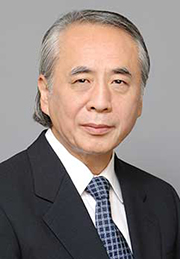Greeting
 | President |
Allen-Barker-Hines’ classic publication Peripheral Vascular Diseases provides a definition for angiology as follows. “The term peripheral vascular diseases in its broadest sense applies to disease of any of the blood vessels outside the heart and to disease of the lymph vessels.” The Japanese College of Angiology is a forum for the discussion of all issues related to angiology, encompassing a wide range of fields such as clinical issues, including those from different fields of medicine, fundamental medicine, including those from different areas, social health issues, and science and technology issues. It was the first academic society founded in Japan. The college’s objectives, as written in its charter, are “to consolidate and develop the latest research in various fields relating to angiology, create systems that allow the outcomes of this research to bring benefits to society, and cultivate the next generation of researchers, and through these objectives, contribute to the development of academic culture and medicine.” During our history of almost 60 years, many other academic societies and research societies have been established, including The Japanese Society for Vascular Surgery, Japanese Society of Phlebology, The Japanese Society of Lymphology, and The Japanese Society of Endovascular Intervention. These societies have evolved into forums for the discussion of more specialized topics. Even though arteriovenous vessels and lymphatic vessels are separate organs, neither can function without consolidation with the other, and neither can exist independently. It is extremely important to understand the workings of these vessels, among all vessel types. As the borders between disciplines overlap more and more, sharing information on technology and techniques reduces unnecessary research and improves the standards of technology. From analysis at the gene level to utilization of big data, recent developments in science and technology have been progressing rapidly, exceeding the advancements made in medicine. It is not uncommon for this technology to be immediately applied and introduced to research on or diagnosis and treatment of vessel disorders. Introducing the science and technology or concepts from other fields, such as medical engineering, is an important issue for the JCA. However, as demonstrated by our involvement in doctors’ salary setting, introducing specialist systems, creating diagnosis guidelines, and holding public lectures, the JCA is not only a forum for academic conversation. Its significance lies in its existence as an association open to the public. Academic societies need to work together to deal with the problems they share, and for issues related to angiology, the JCA must be the core association to take on responsibility for solving them. The JCA widely promotes international cooperation between academic societies from the point of view of standardization in the diagnosis and treatment, and people expect the JCA to be a leader not only in Japan but as a representative angiology society of Asia. Consolidation and differentiation are not conflicting concepts; they exist in unity as they mutually complement each other. I hope that the JCA will continue to grow and develop as a consolidated society for angiology.
その他のAbout JCA
- 2016年3月20日History of the Collegium Japonicae Angiologicae
- 2016年3月15日Executive Committee